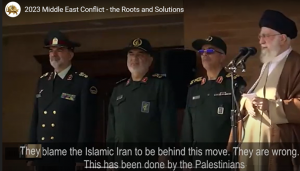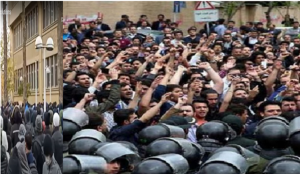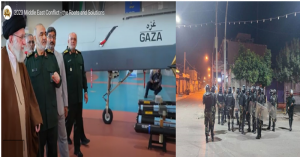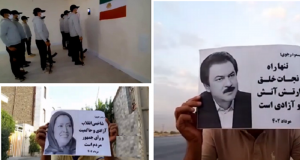(Video) Iran: From Roots to Solutions: A Deep Dive into Crisis and War in the Middle East

As the world watched in shock on October 7, a new conflict erupted in the Middle East, leaving many countries and analysts bewildered. The sudden outbreak of hostilities , raising questions about what they failed to see and what they should have anticipated.

After, Oct. 7 intense discussions, most of which centered on Iran’s role in the crisis, initially Iranian regime defended the attack, hailing it as a victory. As the U.S. deployed warships to the region and increased its military presence, their rhetoric shifted.

To comprehend Iran’s motives in the ongoing crisis, it becomes imperative to understand the regime’s overarching objectives and its persistent intervention in the region. Only by examining why Iran chose to instigate this crisis at this particular juncture.
The regime’s aim is to ensure its continued hold on power, employing this method to cloak its internal vulnerabilities and maintain its grip on the nation.
The events that transpired post-October 7 triggered intense discussions, most of which centered on Iran’s role in the crisis. Initially, Iranian regime officials vehemently defended the attack, hailing it as a significant victory. However, as the U.S. deployed warships to the region and increased its military presence, its rhetoric shifted. They claimed this was a “completely Palestinian” decision, asserting Iran had no role in the planning and execution.
Despite the varying viewpoints, most analysts concur on a critical point: whether or not Iran was directly involved, its financial, weapons, and training support has played a pivotal role in creating the crisis. The proxy forces of the Iranian regime owe their current standing to this support, making Iran a central figure responsible for the ongoing turmoil in the region.
Therefore, to address the crisis comprehensively, most analysts agree that the key lies in addressing its root cause: Iran.
The pressing question now is why Iran chose to foster this crisis in the region and what objectives it seeks to achieve. Equally significant is the exploration of potential solutions to this crisis and the actions required to alleviate the situation.
Understanding the Iranian regime’s Goals in the Crisis
To comprehend Iran’s motives in the ongoing crisis, it becomes imperative to retrace the steps and understand the regime’s overarching objectives and its persistent intervention in the region. Only by examining this can one truly fathom why Iran chose to instigate this crisis at this particular juncture.
Since its ascent to power following the 1979 revolution, the Iranian regime has anchored its governance on two fundamental principles. The first revolves around internal repression, while the second centers on the global dissemination of crisis under the pretext of the “export of revolution.”
This strategic framework was chosen in response to the regime’s incapacity to effectively address the challenges of a progressive society post the anti-monarchical revolution. Hampered by its antiquated and archaic disposition, the clerical regime struggled to meet the aspirations of the Iranian populace, who yearned for democratic reforms, social liberties, and individual freedoms.
Recognizing the need to preserve their authority, the clerics deduced that the suppression of internal dissent and the exportation of internal conflicts beyond national borders were essential. Consequently, the Islamic Revolutionary Guard Corps (IRGC) was established with a dual mission: quelling domestic opposition and engineering unrest and conflict outside Iran’s territorial boundaries, thereby exporting the regime’s crises abroad.
For the past four decades, Iran’s aggressive regional interventions have been conspicuous. Eight years of war with Iraq, coupled with a history of fomenting hostilities in Lebanon, Yemen, and Syria, have been accompanied by the strategic establishment of proxy groups, notably Hezbollah in Lebanon and Islamic Jihad in Palestine, and in other regional territories.
During the past four decades, the regime has repeatedly sought to counter internal crises by fanning the flames of external turmoil. The regime’s Supreme Leader, Ai Khamenei, and other regime leaders have consistently acknowledged that failure to engage in conflicts in Syria and Lebanon would inevitably lead to battles within Tehran and across the streets of Iran.
Moreover, the regime’s leaders have emphasized Lebanon and Syria’s pivotal significance as their strategic depth, underscoring that their endeavors to foment crises beyond Iran’s borders do not stem from any genuine concern for the well-being of the Palestinian people or the broader region.
Instead, these actions serve as a calculated sacrifice of thousands of Palestinians and people of the region to ensure the preservation of the regime’s power, thus diverting attention from its internal challenges. This policy has remained the cornerstone of the regime’s governance for over four decades.
In effect, this approach has transformed Iran into a primary state sponsor of global terrorism. Unfortunately, the West’s policy of appeasement has not only failed to curb the regime’s belligerent stance but has emboldened its destructive endeavors.
Western powers have not only refrained from decisive action against the regime’s terrorist activities and malign conduct in the region but have also provided the regime with a shield through their lenient stance and inaction.
The events of October 7 and the following crisis align with this established pattern. It is crucial to recognize that the regime’s primary objective in fomenting this crisis is not rooted in genuine sympathy for the Palestinian cause. Instead, it serves as a calculated maneuver to sacrifice the lives of thousands of Palestinians and Jews to divert attention from a more significant crisis within Iran and facilitates the suppression of domestic protesters.
The regime’s ultimate aim is to ensure its continued hold on power, employing this method to cloak its internal vulnerabilities and maintain its grip on the nation.
The internal crisis gripping the Iranian regime manifests in the form of widespread uprisings and calls for its overthrow by the Iranian people.
A Glance at Iran’s Internal Crisis and its Need for an International Crisis
Since 2017, a series of uprisings have reverberated throughout Iran, steadily gaining momentum and evolving into a formidable force demanding the establishment of a democratic government.
The principal opposition, the People’s Mojahedin Organization of Iran (PMOI/MEK) and its Resistance Units within Iran, have played a pivotal role in organizing and mobilizing these uprisings. Despite the regime’s relentless and brutal crackdowns on both the uprisings and the Resistance Units, the fervor for change has only intensified.
Each successive wave of dissent has not only grown larger but has also spread more extensively across the nation, with the People’s Mojahedin Organization of Iran (PMOI/MEK)Resistance Units gaining ground nationwide.
Realizing the potent threat posed by these uprisings, the regime undertook a series of calculated measures. The installation of Ebrahim Raisi, a key figure involved in the 1988 massacre of political prisoners, as the President, served to consolidate the regime’s ranks and solidify internal unity.
Raisi’s infamous role in the mass execution of over 30,000 political prisoners, predominantly comprising members and sympathizers of the MEK, underscores the regime’s brutal suppression tactics.
Further exacerbating the situation, the regime opted to escalate its uranium enrichment activities, intentionally triggering an international crisis in the nuclear arena. Simultaneously, it heightened its global terrorist activities, as evidenced by a foiled plot in 2018 to bomb the annual meeting of the Iranian Resistance in Paris.
In September 2022, a watershed moment transpired as the Iranian populace orchestrated the largest and most protracted uprising in the nation’s history, directed squarely at the regime.
In a bold and direct challenge to the regime’s authority, the people specifically targeted its figurehead, Ali Khamenei, with resounding chants of “Death to Khamenei” and “Death to the dictator.” The regime was acutely aware that the uprising posed an imminent threat to its very existence.
Despite their concerted efforts to quell the uprising, including the ruthless slaying of over 750 protesters and the arbitrary imprisonment and torture of more than 20,000 individuals, the regime understood that the Iranian society simmered beneath the surface, poised to erupt at any given moment.
The proliferation and expansion of the MEK Resistance Units across the nation served as a catalytic force, swiftly transforming localized protests into a formidable national movement challenging the regime’s grip on power.
Faced with this internal turmoil, Khamenei’s strategic response materialized in the form of exacerbating a significant crisis beyond Iran’s borders. The regional turmoil, which commenced on October 7, was meticulously engineered to thwart the burgeoning uprising within Iran. It was a deliberate maneuver intended to stifle the momentum of the people’s movement and forestall any possibility of the regime’s overthrow.
Exploring Viable Solutions and Actions
Analyzing the events in the Middle East over the past four decades reveals that the Iranian regime is identified as the fundamental source of crises and challenges in the region, acting as a significant impediment to achieving peace.
In the current crisis, a pivotal question emerges: should the Iranian regime be perceived as an integral part of the solution or as the root cause of the problem? Some argue that the Iranian regime’s reluctance to engage in direct warfare should be construed as a willingness to contribute to a resolution.
Advocates of this view propose that the Iranian regime be urged to leverage its influence over proxy groups, thereby curbing the proliferation of conflict through these surrogate forces.
Conversely, others contend that engaging with the Iranian regime in this manner entails overlooking the core issue. They assert that such an approach neglects the underlying agenda of the Iranian regime, which aims to establish hegemony in the region.
According to this perspective, the regime is not merely an influencer but the orchestrator behind proxy forces, exercising direct control. It posits that the regime issues directives for continued attacks, exacerbating crises in the region.
Considering these divergent viewpoints, it becomes imperative to explore various scenarios:
First Scenario: Continuation of the Status Quo
The prevailing crisis in the Middle East can be attributed to the West’s policy of appeasement towards Iran and its reluctance to acknowledge the destructive actions of the Iranian regime over the past four decades.
Iranian regime lobbies in the West have persistently asserted that any significant confrontation with Iran would escalate into a war between the US and Iran. Exploiting the guise of promoting peace and averting a conflict between the two nations, these lobbies have actively advocated for the policy of appeasement.
Influential groups in the West, swayed by the same narrative, have chosen to overlook the interventions of the Iranian regime, all in the name of preventing a war between the US and Iran.
Unfortunately, this policy has not only failed to prevent war but has inadvertently enabled the Iranian regime to fuel bloody conflicts in the region for years. The Iranian regime has been instrumental in financing, arming, and training proxy forces in various countries, resulting in the proliferation of violence.
The Iranian regime’s proxy forces, particularly in Iraq, have instigated a sectarian war that has claimed thousands of lives. Similarly, in Syria, Iranian-backed forces have been responsible for the deaths of thousands of Syrians.
This cycle of war and bloodshed has persisted across the region, with the Houthis in Yemen and Hezbollah in Lebanon being additional manifestations of Iran’s destabilizing influence. The consequences of this appeasement policy are evident today, with the region embroiled in yet another significant conflict.
The origin of the narrative suggesting that the provocation of the Iranian regime could lead to a war with the United States can be traced back to the Iranian regime itself.
Over the years, the regime and its lobbies in the West have propagated this narrative to such an extent that it has been ingrained as a “proven fact” in the political circles of the West. Many governments and political parties consider it an indisputable reality.
However, a deeper understanding of the Iranian regime’s motivations for intervention in the region and its penchant for warmongering reveals a more nuanced perspective.
Contrary to the narrative perpetuated by the regime, those familiar with the reasons behind the Iranian regime’s interventions recognize that a direct war with the U.S. and the West poses an existential threat to the regime. The regime strategically employs a policy of exporting internal crises and engaging in foreign warmongering to prevent the extension of conflict within Iran itself.
The ultimate goal is not to incite war for the regime but rather to safeguard its existence. Consequently, the regime intervenes in other countries through proxies, avoiding direct responsibility.
The regime’s Supreme Leader Ali Khamenei explicitly articulated this strategy during a speech amid the regime’s tensions with the Trump administration on August 13, 2018, when the prospect of war seemed imminent. Khamenei emphatically stated, “There will be no war and we will not negotiate.”
He clarified that the avoidance of war was rooted in the understanding that both sides, Iran and the U.S., stood to lose significantly in the event of armed conflict.
In essence, the regime’s interventions in other countries through proxies are solely aimed at maintaining its grip on power, concealing internal crises, and preempting uprisings that could threaten its rule.
Turning a blind eye to these interventions and appeasing the regime only serves to fuel its strategic objectives. Understanding the regime’s motivations is crucial for crafting informed policies that promote stability and accountability in the region.
In the current crisis, despite the evident connection between the proxy forces of the Iranian regime and the Iranian regime itself, certain lobbies and apologists for Iran persistently downplay Iran’s role, insisting that the crisis is solely a Palestinian-Israeli issue.
They vehemently oppose any mention of Iran in this context and label those who point to Iran as warmongers seeking to escalate tensions between the US and Iran. This tactic follows a familiar pattern of inducing fear of war to discourage scrutiny of Iran’s actions, ultimately paving the way for continued appeasement.
Rather than addressing the root cause of the problem – Iran’s involvement – these groups attempt to redirect attention, only acknowledging a portion of the issue. However, in the aftermath of the regional disaster unfolding, the consequences are expected to be more severe than in previous instances. Some of these repercussions include:
1. The Iranian regime, along with its proxy forces, emerges as a hegemonic force in the region, consolidating its control over strategically vital points. This enables the regime to strengthen its influence over key strategic locations in the region.
2. The Iranian regime intensifies the engagement of its proxy entities in regional conflicts, perpetuating a cycle of violence and bloodshed. This creates an environment conducive to the proliferation of terrorist activities. It also leads to a rise in the frequency and intensity of attacks against neighboring countries and institutions deemed contrary to the interests of the Iranian regime, thereby diminishing the prospects for peace in the Middle East.
To continue refer to this link, please. https://www.ncr-iran.org/en/news/terrorism-a-fundamentalism/crisis-and-war-in-the-middle-east-the-roots-and-solutions/
To subscribe weekly Newsletter of NCRI use this link, please . https://bit.ly/3SMgEla
Shahin Gobadi
NCRI
+33 6 61 65 32 31
email us here
The internal crisis gripping the Iranian regime manifests in the form of widespread uprisings and calls for its overthrow by the Iranian people.
Legal Disclaimer:
EIN Presswire provides this news content "as is" without warranty of any kind. We do not accept any responsibility or liability for the accuracy, content, images, videos, licenses, completeness, legality, or reliability of the information contained in this article. If you have any complaints or copyright issues related to this article, kindly contact the author above.


